
The Irish Rebellion of 1798 was a popular insurrection against the British Crown in what was then the separate, but subordinate, Kingdom of Ireland. The main organising force was the Society of United Irishmen. First formed in Belfast by Presbyterians opposed to the landed Anglican establishment, the Society, despairing of reform, sought to secure a republic through a revolutionary union with the country's Catholic majority. The grievances of a rack-rented tenantry drove recruitment.
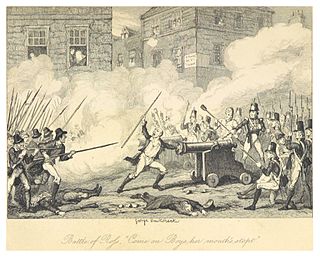
The Battle of New Ross was a military engagement which took place in New Ross, County Wexford during the Irish Rebellion of 1798. It was fought between the Society of United Irishmen rebels and government forces garrisoning the town. The attack on the town of New Ross on the River Barrow, was an attempt by the recently victorious rebels to break out of county Wexford across the river Barrow and to spread the rebellion into county Kilkenny and the outlying province of Munster.
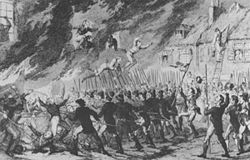
The Battle of Prosperous was a military engagement between British Crown forces and United Irishmen rebels during the Irish Rebellion of 1798 in the town of Prosperous, County Kildare. Prosperous was founded by Sir Robert Brooke in 1780 as a village for processing cotton produced in the Americas. When a rebellion spearheaded by the United Irishmen broke out against British rule in Ireland, rebel forces led by John Esmonde made plans to capture Prosperous. Esmonde had 200 rebels under his command, while Prosperous was garrisoned by elements of the Royal Cork City Militia under the command of Captain Richard Swayne reinforced by detachments of a Welsh mounted fencible regiment, the Ancient British Regiment of Fencible Cavalry Dragoons, numbering 150 men in all.
The Battle of Ballymore-Eustace was one of the events in the United Irish rebellion of 1798. It took place on 24 May 1798 after the stationing of the 9th Dragoons, and members of the Tyrone, Antrim and Armagh Militias at Ballymore in County Kildare near the Kildare-Wicklow border on 10 May. The town had been recently garrisoned by almost 200 soldiers and militia who had been sent to repress sedition in the area. The troops had been dispersed in billets among the populace as per counter-insurgency practice of "free-quarters" where responsibility for the provisioning and sheltering of militia was foisted onto the populace. During this time a quantity of arms were surrendered and letters of protection issued.
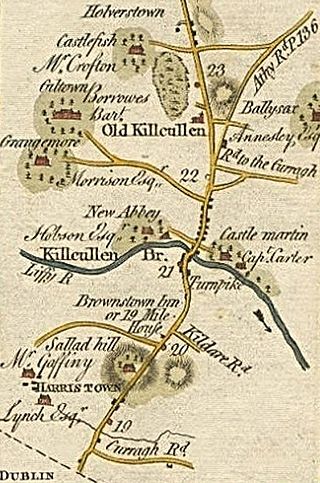
The Battle of Kilcullen took place on 24 May 1798 near the two settlements of that name in County Kildare, and was one of the first engagements in the Irish Rebellion of 1798 consisting of two separate clashes between a force of United Irish rebels and British military.

The Battle of Vinegar Hill was a military engagement during the Irish Rebellion of 1798 on 21 June 1798 between a force of approximately 13,000 government troops under the command of Gerard Lake and 16,000 United Irishmen rebels led by Anthony Perry. The battle, a major rebel defeat, took place on 21 June 1798 on a large rebel camp on Vinegar Hill and in the streets of Enniscorthy, County Wexford and marked the last major attempt by the rebels to hold and control territory taken in Wexford.
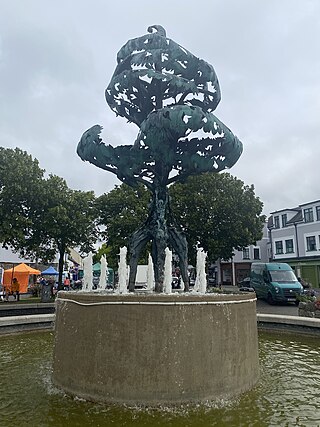
The Battle of Carlow took place in Carlow town, Ireland on 25 May 1798 when Carlow rebels rose in support of the 1798 rebellion which had begun the day before in County Kildare. The United Irishmen organisation in Carlow led by a young brogue-maker named Mick Heydon who had taken over the leadership following the arrest of the previous leader, Peter Ivers, who was arrested with several other leading United Irishmen at Oliver Bond's house in March of that year, had assembled on the night of the 24th and set off at dawn to attack the county town. Picking up more volunteers along the way, their numbers swelled to around 1,200 they marched completely unopposed.
The Carnew executions refer to the summary execution of 28 prisoners being held as suspected United Irishmen by yeomanry troops from the Carnew garrison stationed in the barracks of Carnew Castle, County Wicklow, Ireland on 25 May 1798.

The battle of Bunclody or Newtownbarry as it was then called, was a battle in the Irish Rebellion of 1798, which took place on 1 June 1798 when a force of some 5,000 rebels led by Catholic priest Fr. Mogue Kearns attacked the garrison at Bunclody.
The Battle of Antrim was fought on 7 June 1798, in County Antrim, Ireland during the Irish Rebellion of 1798 between British troops and Irish insurgents led by Henry Joy McCracken. The British won the battle, beating off a rebel attack on Antrim town following the arrival of reinforcements but the county governor, John O'Neill, 1st Viscount O'Neill, was fatally wounded.
The battle of Ovidstown was a military engagement between British Crown forces and United Irishmen rebels during the Irish Rebellion of 1798 near the town of Kilcock, County Kildare. Despite the initial failures experienced by the United Irishmen in County Kildare during the first months of the rebellion, the consolidation of government forces in the town of Naas and the priority given by the Dublin Castle administration to suppress the Wexford Rebellion in County Wexford meant that much of the county remained in rebel hands since the outbreak of the rebellion. Towns such as Prosperous and Clane were in rebel hands, while towns such as Maynooth, Kilcock and Kildare had been attacked and briefly occupied by the rebels. By 19 June, however, neighbouring County Meath had been judged sufficiently pacified to allow for government forces to be dispatched from that county into Kildare to recapture rebel-held territory.
County Kildare in the province of Leinster, Ireland, was first defined as a diocese in 1111, shired in 1297 and assumed its present borders in 1836. Its location in the Liffey basin on the main routes from Dublin to the south and west meant it was a valuable possession and important theatre of events throughout Irish history.

John Murphy was an Irish Roman Catholic priest of the Roman Catholic Diocese of Ferns, who is mainly remembered for his central role in the Irish Rebellion of 1798 in County Wexford, which is sometimes known as the Wexford Rebellion. He led the rebels to one of their initial victories over a government militia at Oulart Hill, and in the following weeks became one of the rebellion's main leaders.
Events from the year 1798 in Ireland.

Carnew is a village in County Wicklow, Ireland. It is the most southerly town in Wicklow situated just a mile from the border with County Wexford. For historical reasons it has often been described as "a Protestant enclave".
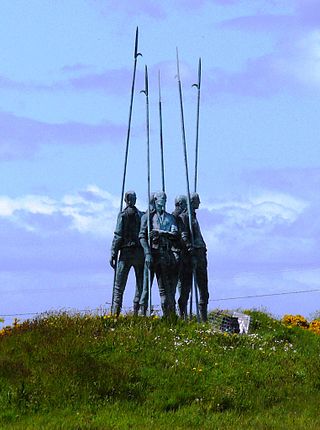
The Wexford Rebellion refers to the outbreak in County Wexford, Ireland in May 1798 of the Society of United Irishmen's rebellion against the British rule. It was the most successful and most destructive of all the uprisings that occurred throughout Ireland during the 1798 Rising, lasting from 27 May 1798 until about 21 June 1798. The Wexford Rebellion saw much early success despite County Wexford not being thought of as an immediate threat by the government, because of the spontaneous risings that occurred both before and after the significant rebel victories in Oulart, Enniscorthy, and Wexford town. The rising in County Wexford was eventually defeated by the British authorities following the Battle of Vinegar Hill.

The battle of Ballynahinch was a military engagement of the Irish Rebellion of 1798 between a force of roughly 4,000 United Irishmen rebels led by Henry Munro and approximately 2,000 government troops under the command of George Nugent. After rebel forces had occupied Newtownards on 9 June, they gathered the next day in the surrounding countryside and elected Munro as their leader, who occupied Ballyhinch on 11 June. Nugent led a column of government troops in 12 June which recaptured the town and bombarded rebel positions. On the next day, the rebels attacked Ballyhinch, but were driven back and defeated.

The Irish rebellion of 1803 was an attempt by Irish republicans to seize the seat of the British government in Ireland, Dublin Castle, and trigger a nationwide insurrection. Renewing the struggle of 1798, they were organised under a reconstituted United Irish directorate. Hopes of French aid, of a diversionary rising by radical militants in England, and of Presbyterians in the north-east rallying once more to the cause of a republic were disappointed. The rising in Dublin misfired, and after a series of street skirmishes, the rebels dispersed. Their principal leader, Robert Emmet, was executed; others went into exile.
Michael Reynolds was the leader of the United Irish Kildare rebels during the Battle of Naas.
The Battle of Rathangan was a military engagement between the forces of the British Crown and the United Irishmen during the 1798 rebellion.











